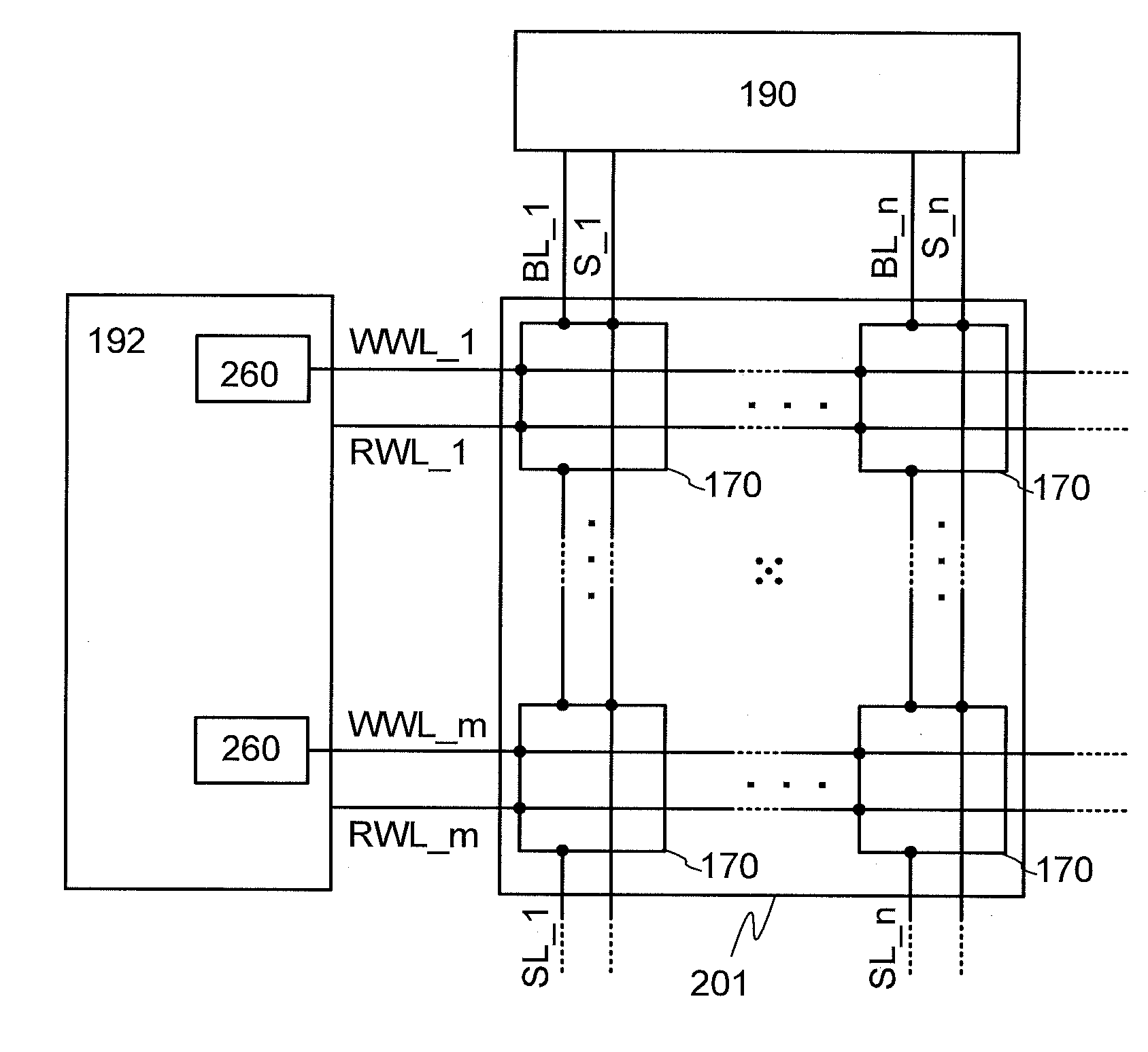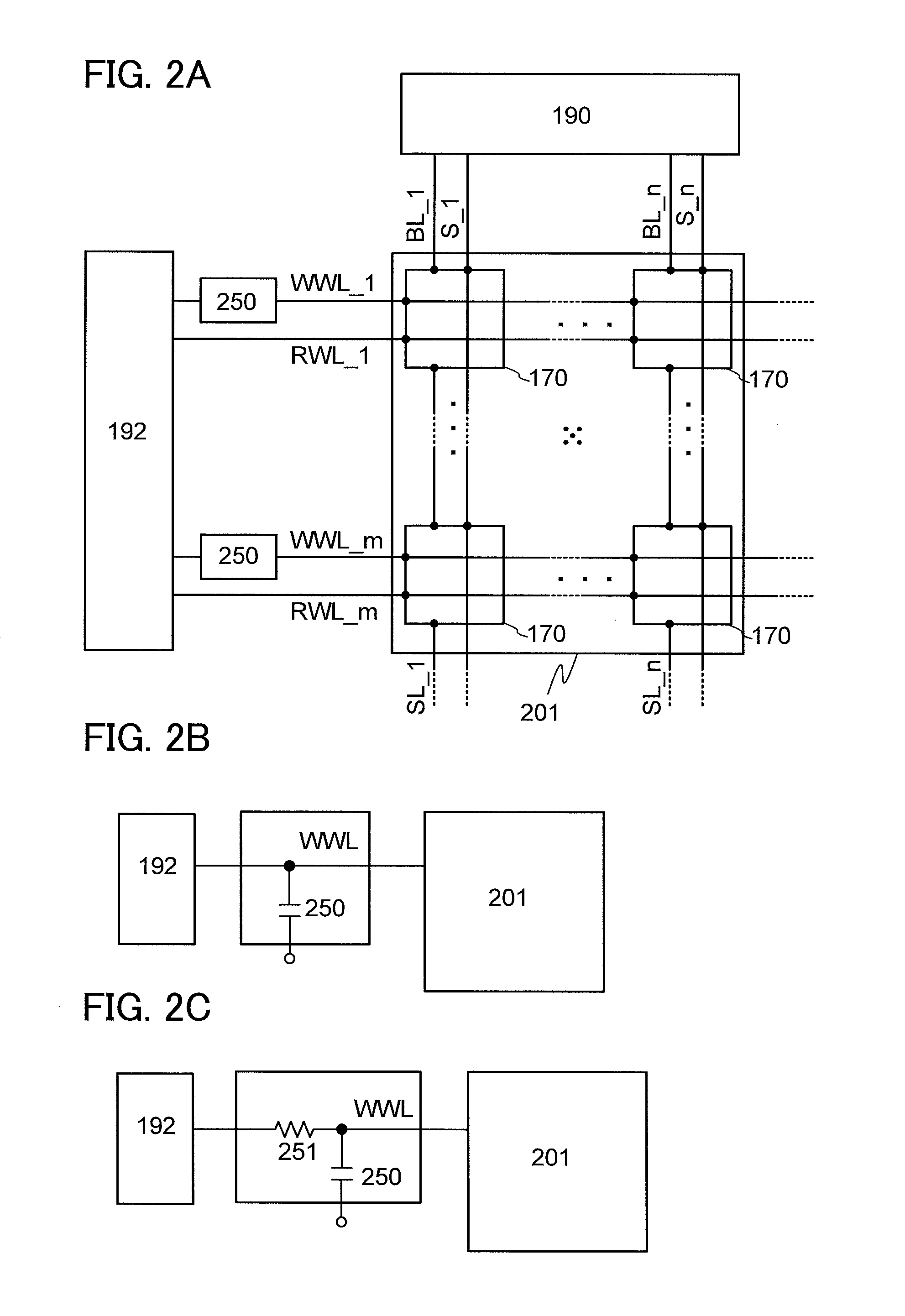Semiconductor device including memory cell array
a memory cell array and semiconductor technology, applied in semiconductor devices, digital storage, instruments, etc., can solve the problems of short data holding period, difficult to sufficiently reduce power consumption, and loss of stored data
- Summary
- Abstract
- Description
- Claims
- Application Information
AI Technical Summary
Benefits of technology
Problems solved by technology
Method used
Image
Examples
embodiment 1
[0053]In this embodiment, a circuit structure and operation of a semiconductor device according to an embodiment of the disclosed invention will be described with reference to FIGS. 1A-1 to 1B and FIGS. 2A to 2C. Note that in each of the circuit diagrams, in some cases, “OS” is written beside a transistor in order to indicate that the transistor includes an oxide semiconductor.
[0054]First, the most basic circuit structure of a memory cell and its operation will be described with reference to FIGS. 1A-1 to 1B. In a semiconductor device including a memory cell illustrated in FIG. 1A-1, a bit line BL and a source electrode (or a drain electrode) of a transistor 160 are electrically connected to each other, and a source line SL and the drain electrode (or the source electrode) of the transistor 160 are electrically connected to each other. In addition, a signal line S and a source electrode (or a drain electrode) of a transistor 162 are electrically connected to each other, and a write ...
application example
[0083]Next, a more specific circuit structure to which the circuit of the memory cell illustrated in FIGS. 1A-1 to 1B is applied and an operation thereof will be described with reference to FIGS. 2A to 2C.
[0084]FIG. 2A is an example of a circuit diagram of a semiconductor device including (m×n) memory cells 170. The structure of the memory cells 170 in FIG. 2A is similar to that in FIG. 1A-1. Note that in FIG. 2A, only the memory cells 170 in the first row are directly connected to the bit lines BL, and only the memory cells 170 in the m-th row are directly connected to the source lines SL. The memory cells 170 in other rows are electrically connected to the bit lines BL and the source lines SL through other memory cells 170 in the same columns.
[0085]The semiconductor device in FIG. 2A includes m (m is an integer of greater than or equal to 2) write word lines WWL, in read word lines RWL, n (n is an integer of greater than or equal to 2) source lines SL, n bit lines BL, n signal lin...
embodiment 2
[0105]In this embodiment, a circuit structure to which the circuit of the memory cell illustrated in FIGS. 1A-1 to 1B is applied and which is different from that in FIGS. 2A to 2C will be described with reference to FIGS. 3A to 3D and FIGS. 4A to 4F.
[0106]FIG. 3A is an example of a circuit diagram of a semiconductor device including (m×n) memory cells 170. The structure of the memory cells 170 in FIG. 3A is similar to that in FIG. 1A-1 and FIG. 2A; therefore, the detailed description thereof is omitted.
[0107]The semiconductor device in FIG. 3A includes a memory cell array 201 including the memory cells 170 arranged in a matrix of m (rows)×n (columns), a first driver circuit 190 connected to n bit lines BL and n signal lines S, and a second driver circuit 192 connected to m write word lines WWL and in read word lines RWL.
[0108]In the semiconductor device illustrated in FIG. 3A, the second driver circuit 192 includes a noise removal circuit 260 that is electrically connected to the wr...
PUM
 Login to View More
Login to View More Abstract
Description
Claims
Application Information
 Login to View More
Login to View More - R&D
- Intellectual Property
- Life Sciences
- Materials
- Tech Scout
- Unparalleled Data Quality
- Higher Quality Content
- 60% Fewer Hallucinations
Browse by: Latest US Patents, China's latest patents, Technical Efficacy Thesaurus, Application Domain, Technology Topic, Popular Technical Reports.
© 2025 PatSnap. All rights reserved.Legal|Privacy policy|Modern Slavery Act Transparency Statement|Sitemap|About US| Contact US: help@patsnap.com



